| Listing 1 - 10 of 17 | << page >> |
Sort by
|
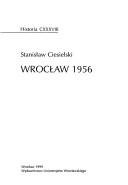
ISBN: 8322919522 Year: 1999 Volume: 2167 CXXXVIII Publisher: Wroclaw Wydawnictwo uniwersytetu wroclawskiego
Abstract | Keywords | Export | Availability | Bookmark
 Loading...
Loading...Choose an application
- Reference Manager
- EndNote
- RefWorks (Direct export to RefWorks)
Poland --- Wroclaw (Poland) --- -History --- -Poland --- Wrocław (Poland) --- Wroslaw (Poland) --- Vrotslav (Poland) --- Breslau (Germany) --- History --- 20th century --- Uprising of 1956
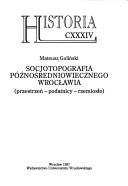
ISBN: 8322917074 Year: 1997 Volume: 2010 CXXXIV Publisher: Wroclaw Wydawnictwo uniwersytetu wroclawskiego
Abstract | Keywords | Export | Availability | Bookmark
 Loading...
Loading...Choose an application
- Reference Manager
- EndNote
- RefWorks (Direct export to RefWorks)
Handicraft industries --- -Industries --- -Industrial production --- Industry --- Economics --- History --- Wroclaw (Poland) --- -Economic conditions --- -History --- Industries --- Industrial production --- Wrocław (Poland) --- Wroslaw (Poland) --- Vrotslav (Poland) --- Breslau (Germany) --- Economic conditions. --- Industries, Primitive
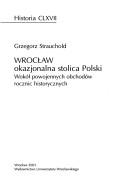
ISSN: 02396661 05244498 ISBN: 8322924240 9788322924242 Year: 2003 Volume: 2569 167 Publisher: Wrocław Wydawnictwo uniwersytetu Wrocławskiego
Abstract | Keywords | Export | Availability | Bookmark
 Loading...
Loading...Choose an application
- Reference Manager
- EndNote
- RefWorks (Direct export to RefWorks)
Wrocław (Poland) --- Poland --- History --- Politics and government --- Wroslaw (Poland) --- Vrotslav (Poland) --- Breslau (Germany) --- Wrocław (Poland) - History - 20th century. --- Poland - Politics and government - 1945-1980.
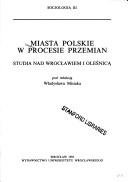
ISBN: 832290780X Year: 1992 Publisher: Wrocław Wydawnictwo uniwersytetu Wrocławskiego
Abstract | Keywords | Export | Availability | Bookmark
 Loading...
Loading...Choose an application
- Reference Manager
- EndNote
- RefWorks (Direct export to RefWorks)
Wroclaw (Poland) --- -Social conditions --- Oleśnica (Województwo Dolnośląskie, Poland) --- Wrocław (Poland) --- Wroslaw (Poland) --- Vrotslav (Poland) --- Breslau (Germany) --- Oleśnica, Poland --- Oleśnica (Wrocław, Poland) --- Oels (Germany) --- Social conditions. --- Pologne --- Conditions sociales --- 20e siecle
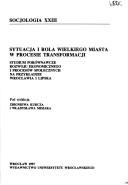
ISBN: 8322915659 Year: 1997 Volume: 1911 23 Publisher: Wroclaw Wydawnictwo uniwersytetu wroclawskiego
Abstract | Keywords | Export | Availability | Bookmark
 Loading...
Loading...Choose an application
- Reference Manager
- EndNote
- RefWorks (Direct export to RefWorks)
Urban policy --- -Urban policy --- -Cities and state --- Urban problems --- City and town life --- Economic policy --- Social policy --- Sociology, Urban --- City planning --- Urban renewal --- Leipzig (Germany) --- -Wroclaw (Poland) --- -Economic conditions --- Economic conditions --- -Leipzig (Germany) --- Cities and state --- Wroclaw (Poland) --- Wroslaw (Poland) --- Vrotslav (Poland) --- Breslau (Germany) --- Leipsic (Germany) --- Laĭptsig (Germany) --- Leipsia (Germany) --- Lipsia (Germany) --- Laixich (Germany) --- Lipsk (Germany) --- Economic conditions.
Book
ISBN: 8322917481 Year: 1998 Volume: 2022 Publisher: Wroclaw Uniwersytet Wroclawski
Abstract | Keywords | Export | Availability | Bookmark
 Loading...
Loading...Choose an application
- Reference Manager
- EndNote
- RefWorks (Direct export to RefWorks)
Precipitation (Meteorology) --- Water --- Weather --- Cloud physics --- Silesia, Lower (Poland and Germany) --- Wrocław (Poland) --- Wroslaw (Poland) --- Vrotslav (Poland) --- Breslau (Germany) --- Dolní Slezsko (Poland and Germany) --- Dolny Śląsk (Poland and Germany) --- Lower Silesia (Poland and Germany) --- Niederschlesien (Poland and Germany) --- Climate.
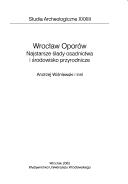
ISSN: 02396661 05209250 ISBN: 8322923503 9788322923504 Year: 2003 Volume: 2485 33 Publisher: Wrocław : Wydawnictwo uniwersytetu Wrocławskiego,
Abstract | Keywords | Export | Availability | Bookmark
 Loading...
Loading...Choose an application
- Reference Manager
- EndNote
- RefWorks (Direct export to RefWorks)
Excavations (Archaeology) --- Paleolithic period --- Czwartorzęd --- Osadnictwo człowieka --- Szczątki roślinne (archeologia) --- Szczątki zwierzęce (archeologia) --- Wykopaliska archeologiczne --- Archeologische vondsten. --- Paleolithicum. --- historia. --- Eolithic period --- Old Stone age --- Palaeolithic period --- Stone age --- Archaeological digs --- Archaeological excavations --- Digs (Archaeology) --- Excavation sites (Archaeology) --- Ruins --- Sites, Excavation (Archaeology) --- Archaeology --- Wrocław (Poland) --- Wroslaw (Poland) --- Vrotslav (Poland) --- Breslau (Germany) --- Antiquities. --- Archeologie prehistorique --- Pologne
Book
ISBN: 9780472121946 0472121944 9780472900596 0472900595 9780472119905 0472119907 Year: 2016 Publisher: Ann Arbor : University of Michigan Press,
Abstract | Keywords | Export | Availability | Bookmark
 Loading...
Loading...Choose an application
- Reference Manager
- EndNote
- RefWorks (Direct export to RefWorks)
"The Breslau arts scene during the Weimar period was one of the most vibrant in all of Germany, yet it has disappeared from memory and historiography. Breslau was a key center for innovative artistic production during the Weimar Republic; recovery of its history will shed new light on German cultural dynamics in the 1920s. Such a study has art historical significance because of the incredible extent of innovation that occurred in almost every intellectual field, advances that formed the basis for aesthetic modernism internationally and continue to affect the course of visual art and architecture today. Architecture education, just one example in many, is still largely based on a combination of the Bauhaus model from the 1920s and the model developed at the Breslau Academy of Fine and Applied Art. The exploratory attitude encouraged in Weimar era arts endeavors, as opposed to the conformism of academic art, is still a core value promoted in contemporary art and architecture circles. Given the long-lasting influence of Weimar culture on modernism one would expect to find a spate of studies examining every aspect of its cultural production, but this is not the case. Recent scholarship is almost exclusively focused on Berlin and the Dessau Bauhaus. Although both interests are understandable, the creative explosion was not confined to these cities but was part of a larger cultural ethos that extended into many of the smaller regional centers. The Expressionist associations the Blaue Reiter in Munich and Brücke in Dresden are two well-known examples. Equally, innovation was not confined to a few monumental projects like the Stuttgart Weissenhofsiedlung but part of a broader national cultural ethos. The dispersion of modernism occurred partly because of the political history of Germany as a loosely joined confederation of small city states and principalities that had strong individual cultural identities before unification in 1871 but also because of the German propensity to value and take intense pride in the Heimat, understood both as the hometown and the region. Heimatliebe translated into generous support for cultural institutions in outlying cities. Host to a roster of internationally acclaimed artists and architects, major collectors, arts organizations, museums, presses, galleries, and one of the premier German arts academies of the day, Breslau boasted a thriving modern arts scene until 1933 when the Nazis began their assault on so-called 'degenerate' art. This book charts the cultural production of Breslau-based artists, architects, art collectors, urban designers, and arts educators, who were especially interesting because they operated in the space between the margins of Weimar-era cultural debates. Rather than accepting the radical position of the German avant-garde or the reactionary position of German conservatives, many Breslauers sought a middle ground. It is the first book in English to address this history and presents the history in a manner unique to any studies currently on the market. Beyond the Bauhaus explores the polyvalent and contradictory nature of cultural production in Breslau in order to expand the cultural and geographic scope of Weimar history; the book asserts a reciprocal dimension to the relationship between regional culture and national culture, between centers like Breslau and the capital Berlin. With major international figures like the painters Otto Mueller and Oskar Moll, architects Hans Scharoun and Adolf Rading, urban planners Max Berg and Ernst May, collectors Ismar Littmann and Max Silberberg, and an art academy that by 1929 was considered the best in Germany, Breslau clearly had significance to narratives of Weimar cultural production. Beyond the Bauhaus contributes the history of German culture during the Weimar Republic. It belongs alongside histories of art, architecture, urban design, exhibition, collecting, and culture; histories of the Bauhaus; histories of arts education more broadly; and German history. The readership would include those interested in German history; German art, architecture, urban design, planning, collecting, and exhibition history; in the avant-garde; the development of arts academies and arts pedagogy; and the history of Breslau and Silesia"--From Google Books.
City and town life --- Arts, German --- Modernism (Aesthetics) --- Aesthetics --- German arts --- City life --- Town life --- Urban life --- Sociology, Urban --- History --- Bauhaus --- Staatliches Bauhaus --- Baohaosi --- Bauhaus Dessau --- Influence --- History. --- Germany --- Wrocław (Poland) --- Breslau (Germany) --- Wroslaw (Poland) --- Vrotslav (Poland) --- Weimar Republic, Germany, 1918-1933 --- Intellectual life --- Civilization
Book
ISBN: 3875848845 Year: 1999 Volume: Bd. 7 Publisher: Berlin Nicolaische Verl.-Buchh. Beuermann
Abstract | Keywords | Export | Availability | Bookmark
 Loading...
Loading...Choose an application
- Reference Manager
- EndNote
- RefWorks (Direct export to RefWorks)
Regional documentation
---
Jewish religion
---
Wroclaw
---
Jews
---
Jewish cemeteries
---
Sepulchral monuments
---
Juifs
---
Cimetières juifs
---
Monuments funéraires
---
Wroclaw (Poland)
---
Wroclaw (Pologne)
---
Buildings, structures, etc.
---
Constructions
---
-Jewish epitaphs
---
-Sepulchral monuments
---
-Jews
---
-#BIBC:ruil

ISBN: 832291976X 9788322919767 Year: 2000 Volume: 2140 Publisher: Wrocław Wydawnictwo uniwersytetu Wrocławskiego
Abstract | Keywords | Export | Availability | Bookmark
 Loading...
Loading...Choose an application
- Reference Manager
- EndNote
- RefWorks (Direct export to RefWorks)
Architecture, Baroque --- Klasztor Św. Macieja we Wrocławiu. --- Wrocław (Poland) --- Buildings, structures, etc. --- -Baroque architecture --- Klasztor Sw. Macieja we Wroclawiu --- Klasztor Świętego Macieja we Wrocławiu --- Kloster zu St. Matthias in Breslau --- Wroclaw (Poland) --- -Buildings, structures, etc --- -Klasztor Sw. Macieja we Wroclawiu --- Baroque architecture --- Klasztor Św. Macieja we Wrocławiu. --- Wroslaw (Poland) --- Vrotslav (Poland) --- Breslau (Germany) --- Architecture baroque --- Architecture, Baroque - Poland - Wrocław. --- Wrocław (Poland) - Buildings, structures, etc. --- Cloitre (st. matthias in breslau, allemagne)
| Listing 1 - 10 of 17 | << page >> |
Sort by
|

 Search
Search Feedback
Feedback About
About Help
Help News
News